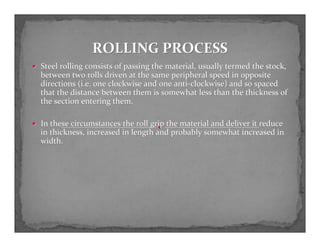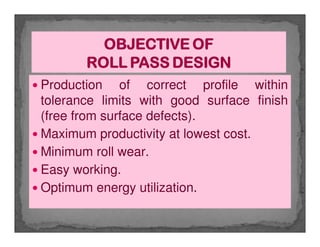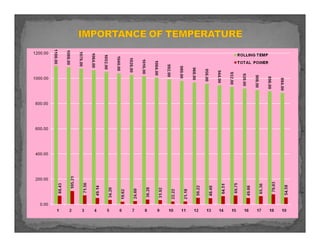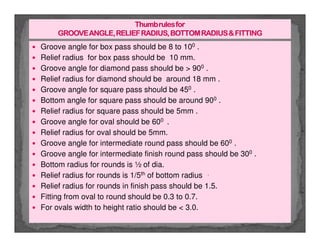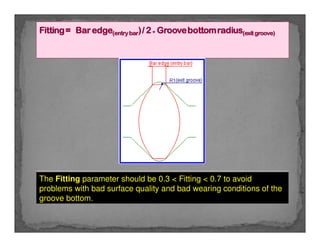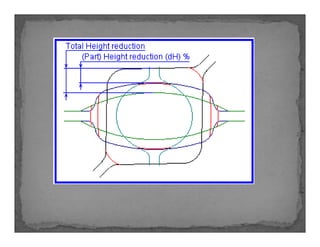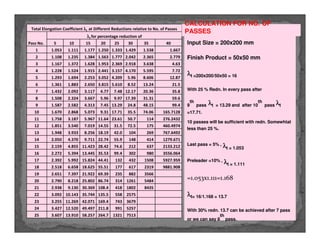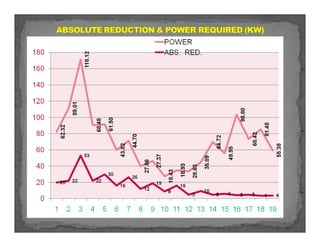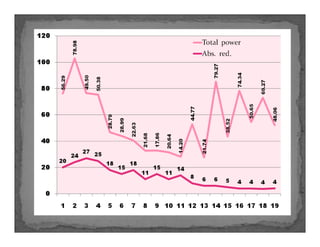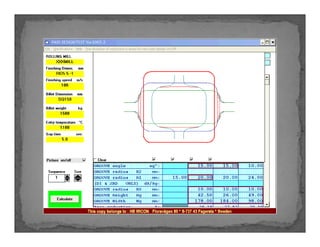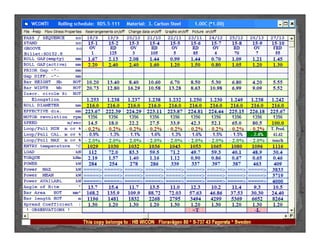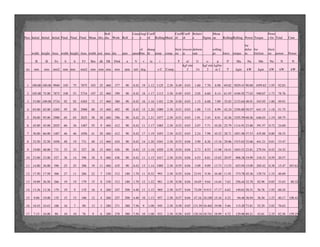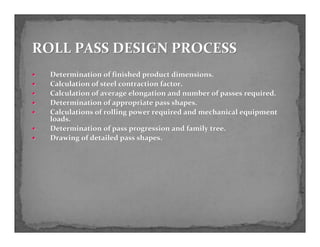A_MukherjeePresn for engineers good file
- 1. ROLL PASS DESIGN EVAULUATION USING SOFTWARE APPLICATION ARINDAM MUKHERJEE PROJECT MANAGEMENT CELL UNDP/GEF PROJECT (STEEL)
- 2. OBJECTIVE OF ROLL PASS DESIGN Steel sections are generally rolled in several passes, whose num Steel sections are generally rolled in several passes, whose number is ber is determined by the ratio of initial input material and final cros determined by the ratio of initial input material and final cross section s section of finished product. of finished product. The cross section area is reduced in each pass and form and size The cross section area is reduced in each pass and form and size of the of the stock gradually approach to the desired profile. stock gradually approach to the desired profile.
- 3. ROLLING ROLLING PROCESS PROCESS Steel rolling consists of passing the material, usually termed t Steel rolling consists of passing the material, usually termed the stock, he stock, between two rolls driven at the same peripheral speed in opposit between two rolls driven at the same peripheral speed in opposite e directions (i.e. one clockwise and one anti directions (i.e. one clockwise and one anti- -clockwise) and so spaced clockwise) and so spaced that the distance between them is somewhat less than the thickne that the distance between them is somewhat less than the thickness of ss of the section entering them. the section entering them. In these circumstances the roll grip the material and deliver it In these circumstances the roll grip the material and deliver it reduce reduce in thickness, increased in length and probably somewhat increase in thickness, increased in length and probably somewhat increased in d in width. width.
- 4. Production of correct profile within tolerance limits with good surface finish (free from surface defects). Maximum productivity at lowest cost. Minimum roll wear. Easy working. Optimum energy utilization.
- 8. Shape of sections in a particular passes must ensure a free metal flow in the roll gap/groove. Appropriate taper/groove angle in pass must be selected in order to avoid metal jamming in rolls. TYPE OF PASS % TAPER Roughing pass 6 to 15 Forming pass 3 to 10 Finish pass 0.5 to 3.0%
- 9. Groove angle for box pass should be 8 to 100 . Relief radius for box pass should be 10 mm. Groove angle for diamond pass should be 900 . Relief radius for diamond should be around 18 mm . Groove angle for square pass should be 450 . Bottom angle for square pass should be around 900 . Relief radius for square pass should be 5mm . Groove angle for oval should be 600 . Relief radius for oval should be 5mm. Groove angle for intermediate round pass should be 600 . Groove angle for intermediate finish round pass should be 300 . Bottom radius for rounds is ½ of dia. Relief radius for rounds is 1/5th of bottom radius . Relief radius for rounds in finish pass should be 1.5. Fitting from oval to round should be 0.3 to 0.7. For ovals width to height ratio should be 3.0.
- 11. The number and arrangement of passes in particular roll stand should assure the most uniform possible exploitation of all the passes in each stand. Uniform draught in last passes different draught in early forming passes of profile , where the section is large metal is hot. Draught should be distributed so as to ensure as far as possible uniform wear and to avoid overloading of drive installations and rolls .
- 12. • Rolls should easily grip the material being rolled . • Pass filling should be correct. Rolls Finish Max. Angle of Bite (in degrees) with reference to speed of mill 0 0.5 1 1.5 2 2.5 3 3.5 Smooth 25.5 24.5 23.5 22.5 19.5 16 12 9 Edged passes 29 27.5 26 24.5 21 17 12 7 Ragged 33 32 31 30 28 26 24 21
- 13. The Fitting parameter should be 0.3 Fitting 0.7 to avoid problems with bad surface quality and bad wearing conditions of the groove bottom.
- 15. An optimum number of passes should be used. If, Too greater in number Lower the out put of the roll stand Too smaller in number Cause excessive roll wear Danger of roll fracture or rolling defect
- 16. Total Elongation Coefficient λ λ λ λt at Different Reductions relative to No. of Passes Pass No. λ λ λ λt for percentage reduction of 5 10 15 20 25 30 35 40 1 1.053 1.111 1.177 1.250 1.333 1.429 1.538 1.667 2 1.108 1.235 1.384 1.563 1.777 2.042 2.365 2.779 3 1.167 1.372 1.628 1.953 2.369 2.918 3.638 4.63 4 1.228 1.524 1.915 2.441 3.157 4.170 5.595 7.72 5 1.293 1.694 2.253 3.052 4.209 5.96 8.606 12.87 6 1.361 1.883 2.650 3.815 5.610 8.52 13.24 21.5 7 1.432 2.092 3.117 4.77 7.48 12.17 20.36 35.8 8 1.508 2.324 3.667 5.96 9.97 17.39 31.31 59.6 9 1.587 2.582 4.313 7.45 13.29 24.8 48.15 99.4 10 1.670 2.868 5.073 9.31 17.71 35.5 74.06 165.7128 11 1.758 3.187 5.967 11.64 23.61 50.7 114 276.2432 12 1.851 3.540 7.019 14.55 31.5 72.5 175 460.4974 13 1.948 3.933 8.256 18.19 42.0 104 269 767.6492 14 2.050 4.370 9.711 22.74 55.9 148 414 1279.671 15 2.159 4.855 11.423 28.42 74.6 212 637 2133.212 16 2.272 5.394 13.445 35.53 99.4 302 980 3556.064 17 2.392 5.992 15.824 44.41 132 432 1508 5927.959 18 2.518 6.658 18.625 55.51 177 617 2319 9881.908 19 2.651 7.397 21.922 69.39 235 882 3566 20 2.790 8.218 25.802 86.74 314 1261 5484 21 2.938 9.130 30.369 108.4 418 1802 8435 22 3.092 10.143 35.744 135.5 558 2575 23 3.255 11.269 42.071 169.4 743 3679 24 3.427 12.520 49.497 211.8 991 5257 25 3.607 13.910 58.257 264.7 1321 7513 CALCULATION FOR NO. OF PASSES Input Size = 200x200 mm Finish Product = 50x50 mm λ λ λ λt =200x200/50x50 = 16 With 25 % Redn. In every pass after 9 th pass λ λ λ λt = 13.29 and after 10 th pass λ λ λ λt =17.71. 10 passes will be sufficient with redn. Somewhtat less than 25 %. Last pass = 5% , λ λ λ λt = 1.053 Preleader =10% , λ λ λ λt = 1.111 =1.053x1.111=1.168 λ λ λ λt= 16/1.168 = 13.7 With 30% redn. 13.7 can be achieved after 7 pass or we can say 8 th pass.
- 17. EVALUATION BASED ON ABSOLUTE REDUCTION Pass Pass Initial Initial Initial Final Final Final Mean Abs. Pass wise no Shape width height Area width height Area width red. Power(Kw) Required for Deformation B H Fo b h F1 Bm dh mm mm mm2 mm mm mm2 mm mm 1 Box 100.00 100.00 9940.00 110.00 80.00 7920.00 105 20 62.32 2 Box 110.00 80.00 7920.00 125.00 58.00 6525.00 118 22 89.01 3 Square 58.00 125.00 6525.00 72.00 72.00 5184.00 65 53 118.12 4 Box 72.00 72.00 5184.00 86.00 50.00 3870.00 79 22 68.48 5 Square 50.00 86.00 3870.00 56.00 56.00 3136.00 53 30 61.50 6 Box 56.00 56.00 3136.00 66.40 40.00 2376.00 61 16 43.82 7 Square 40.00 66.40 2376.00 40.00 40.00 1600.00 40 26 44.70 8 Oval 40.00 40.00 1600.00 48.00 28.00 1055.04 44 12 27.86 9 Square 28.00 48.00 1055.04 29.00 29.00 841.00 29 19 27.37 10 Oval 29.00 29.00 841.00 36.00 20.00 565.20 33 9 18.43 11 Square 20.00 36.00 565.20 20.00 20.00 400.00 20 16 18.93 12 Oval 20.00 20.00 400.00 24.00 15.00 282.60 22 5 28.63 13 Square 15.00 24.00 282.60 14.50 14.50 210.25 15 10 35.09 14 Oval 14.50 14.50 210.25 18.00 9.50 134.24 16 5 64.72 15 Round 9.50 18.00 134.24 12.00 12.00 113.04 11 6 49.95 16 Oval 12.00 12.00 113.04 15.00 7.50 88.31 14 5 98.80 17 Round 7.50 15.00 88.31 10.00 10.00 78.50 9 5 68.42 18 Oval 10.00 10.00 78.50 12.00 6.30 59.35 11 4 81.48 19 Round 6.30 12.00 59.35 8.00 8.00 50.24 7 4 55.38
- 29. +T Risk of tilting in the next groove due to too large width -T Risk of tilting in the next groove due to too small width +F The ratio Bar Edge/Groove Bottom Diameter of the next groove is 0.7 +O Overfilling (Bar widthGroove Width) +W Width of finishing dimensions is more than 1.5% TOO LARGE -W Width of finishing dimensions is more than 1.5% TOO SMALL +D Sb,Db or Hb of finishing dimensions is more than 1.5% Too Large -D Sb,Db or Hb of finishing dimensions is more than 1.5% Too Small +L Loop Growth by repeater rolling is TOO LARGE . Tension by block rolling is TOO SMALL -L Loop Growth by repeater rolling is TOO SMALL . Tension by block rolling is TOO LARGE -N Motor revolution is below the base revolution . Full power is not available
- 30. Pass Initial Initial Initial Final Final Final Mean Abs. Roll dia. Work Roll Linea r Angl e Coeff of RollingMetal Coeff of Coeff of Relativ e Sigma Mean sp. RollingRolling Power Torque Powe r for Total Cum width height Area width height Area width red. max. dia rpm speed of bite draug ht temp comp. fricti on viscosi ty deform rate rolling pr. force torque for defor m. for friction fricti on power Power B H Fo b h F1 Bm dh Dk Dwk n V /u t F n/ U o- p P Ma Na Mn Nn N N no mm mm mm2 mm mm mm2 mm mm mm mm rpm m/s deg. o C Comp. kgf s/m 2 1/s kgf s/m 2 kgf/m m 2 T kgm kW kgm kW kW kW 1 100.00 100.00 9940 105 75 7875 103 25 460 377 90 0.42 19 1.12 1125 2.30 0.49 0.03 1.60 7.70 8.98 69.82 5029.41 90.88 1059.82 1.95 92.83 2 105.00 75.00 7875 109 53 5724 107 22 460 399 90 0.42 18 1.17 1113 2.30 0.49 0.03 2.05 6.60 8.14 61.93 4184.92 77.03 940.07 1.73 78.76 3 53.00 109.00 5724 92 92 4265 72 17 460 380 90 0.42 16 1.16 1101 2.30 0.50 0.03 1.15 6.88 7.89 35.83 2133.64 48.91 543.95 1.00 49.91 4 65.00 65.00 4265 95 50 2980 80 15 460 402 90 0.42 15 1.20 1089 2.30 0.51 0.03 1.88 7.15 8.99 42.24 2356.80 50.57 641.15 1.18 51.75 5 50.00 95.00 2980 65 65 2025 58 30 460 396 90 0.42 21 1.21 1077 2.30 0.51 0.03 1.91 7.43 8.91 42.56 3355.59 68.56 646.03 1.19 69.75 6 45.00 45.00 2025 66 36 1487 55 9 460 412 90 0.42 11 1.17 1065 2.30 0.52 0.03 2.07 7.71 10.26 25.79 1114.91 23.88 391.57 0.72 24.60 7 36.00 66.00 1487 46 46 1056 41 20 460 412 90 0.42 17 1.19 1053 2.30 0.52 0.03 2.24 7.98 10.32 28.71 1851.96 37.53 435.88 0.80 38.33 8 32.50 32.50 1056 48 19 731 40 13 460 424 90 0.42 14 1.20 1041 2.30 0.53 0.04 3.90 8.26 13.16 29.06 1515.63 32.66 441.21 0.81 33.47 9 19.00 48.00 731 33 33 527 26 15 460 426 90 0.42 15 1.18 1029 2.30 0.54 0.04 2.73 8.53 11.98 18.41 1043.51 23.81 279.54 0.52 24.32 10 23.00 23.00 527 36 14 396 30 9 460 436 90 0.42 11 1.15 1017 2.30 0.54 0.04 4.53 8.81 15.62 20.97 906.38 19.99 318.33 0.59 20.57 11 14.00 36.00 396 25 25 306 19 11 460 435 90 0.42 13 1.14 1005 2.30 0.55 0.04 3.09 9.09 13.73 13.53 653.94 15.09 205.42 0.38 15.47 367.61 12 17.50 17.50 306 27 11 266 22 7 330 312 180 1.70 11 0.32 993 2.30 0.55 0.04 23.91 9.36 16.40 11.91 373.78 45.36 129.74 1.33 46.69 13 10.89 26.50 266 19 19 179 15 8 330 312 180 1.70 12 1.22 981 2.30 0.56 0.04 16.05 9.64 14.44 7.62 256.44 32.78 82.96 0.85 33.63 80.32 14 13.36 13.36 179 19 9 135 16 4 260 247 290 4.40 11 1.15 969 2.30 0.57 0.04 72.09 9.913 17.17 6.62 149.61 58.31 56.76 1.92 60.24 15 9.00 19.00 135 15 15 106 12 4 260 257 290 4.40 10 1.13 957 2.30 0.57 0.04 47.16 10.189 15.16 4.23 94.46 38.94 36.30 1.23 40.17 100.41 16 10.43 10.43 106 16 7 90 13 3 280 271 380 7.56 9 1.08 945 2.30 0.58 0.05 131.59 10.465 19.98 5.66 115.20 73.81 52.29 2.82 76.63 17 7.15 16.00 90 10 10 78 9 6 280 278 380 7.56 10 1.08 933 2.30 0.58 0.05 120.34 10.741 18.99 4.72 129.96 80.21 43.61 2.35 82.56 159.19
- 31. CHARACTERISTICS OF A GOOD CHARACTERISTICS OF A GOOD ROLL PASS DESIGN ROLL PASS DESIGN To ensure a profile with a smooth surface and correct dimensions To ensure a profile with a smooth surface and correct dimensions within the stipulated limits of standards. within the stipulated limits of standards. To ensure the minimum expense in terms of energy, power and rol To ensure the minimum expense in terms of energy, power and roll l consumption, consumption, To give deformation in such a way and at stages to have minimum To give deformation in such a way and at stages to have minimum internal stresses in the finished product. internal stresses in the finished product. To create a simple and convenient work culture at stand, minimiz To create a simple and convenient work culture at stand, minimizing ing the manual operation to the minimum possible extent and to intro the manual operation to the minimum possible extent and to introduce duce the automation of technological process. the automation of technological process. To optimize the number of passes required for rolling to reduce To optimize the number of passes required for rolling to reduce the the total rolling time cycle, with minimum time spent for changing a total rolling time cycle, with minimum time spent for changing and nd adjusting of rolls. adjusting of rolls.
- 32. ROLL PASS DESIGN PROCESS ROLL PASS DESIGN PROCESS Determination of finished product dimensions. Determination of finished product dimensions. Calculation of steel contraction factor. Calculation of steel contraction factor. Calculation of average elongation and number of passes required. Calculation of average elongation and number of passes required. Determination of appropriate pass shapes. Determination of appropriate pass shapes. Calculations of rolling power required and mechanical equipment Calculations of rolling power required and mechanical equipment loads. loads. Determination of pass progression and family tree. Determination of pass progression and family tree. Drawing of detailed pass shapes. Drawing of detailed pass shapes.
- 33. TYPICAL HEATING SCHEDULE TYPICAL HEATING SCHEDULE 1180 1180- -1200 1200 High High- -speed steels speed steels VII VII 1200 1200- -1220 1220 Nichrome Nichrome and stainless steels and stainless steels VI VI 1100 1100- -1120 1120 Carbon and medium alloy steel; tool and high manganese Carbon and medium alloy steel; tool and high manganese steels (up to 1.3%C) steels (up to 1.3%C) V V 1120 1120- -1140 1140 Carbon and alloy steel; tool and bearing steel (up to 1%C) Carbon and alloy steel; tool and bearing steel (up to 1%C) IV IV 1140 1140- -1160 1160 Carbon and medium alloy steel (up to 0.9%C) Carbon and medium alloy steel (up to 0.9%C) III III 1180 1180- -1200 1200 Carbon, low Carbon, low- -and medium alloy steels (up to 0.65%C) and medium alloy steels (up to 0.65%C) II II 1200 1200- -1220 1220 Carbon and low Carbon and low- -alloy steels (up to 0.45% C) alloy steels (up to 0.45% C) I I Temperature,OC Temperature,OC Type of steel Type of steel Group Group



